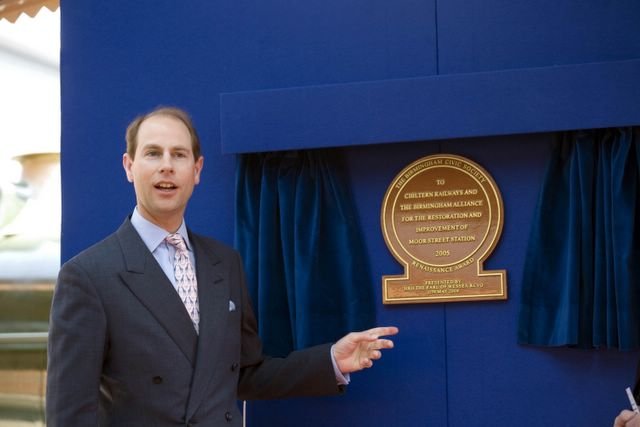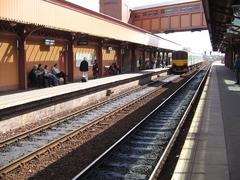
Birmingham Moor Street Railway Station: Visiting Hours, Tickets, and Travel Guide
Date: 14/06/2025
Introduction
Birmingham Moor Street Railway Station is a remarkable fusion of Edwardian heritage and modern rail convenience at the heart of Birmingham, UK. Opened in 1909 to reduce congestion at the nearby Snow Hill station, Moor Street has grown from a modest terminus into one of the city’s busiest and most architecturally significant transport hubs. Its distinctive Grade II listed red-brick façade, timber canopies, and period signage offer visitors a window into early 20th-century railway design, all meticulously preserved and enhanced through careful restoration and ongoing redevelopment (Disused Stations; Midlands Connect; BBC Birmingham).
Today, Moor Street is Birmingham’s second busiest station, providing direct services to London Marylebone and regional destinations. The station is fully accessible, with step-free access, tactile paving, and assistance services for all passengers (National Rail Accessibility Guide; Railway 200). Its central location places visitors within easy reach of the Bullring Shopping Centre, Birmingham Cathedral, and the Jewellery Quarter.
This guide offers comprehensive details on visiting hours, ticketing, travel tips, special events, and architectural highlights, ensuring you have all the information you need for an enjoyable visit to one of Birmingham’s most treasured landmarks. For real-time updates and convenient travel planning, consider downloading the Audiala app.
Origins and Architectural Heritage
Early Development (1909–1940s)
Moor Street was conceived by the Great Western Railway (GWR) to ease congestion at the main Snow Hill terminus. Construction began in 1908, and the station opened in 1909 with temporary facilities, soon upgraded as demand grew. The addition of relief lines in 1913 and a goods depot in 1914 established Moor Street as a major urban terminus (Disused Stations).
Edwardian Design and Preservation
The station’s original red-brick façades, decorative stonework, and timber canopies epitomize Edwardian architectural elegance. These features, now Grade II listed, have been carefully preserved, making Moor Street a rare survivor among Birmingham’s pre-war stations (BBC Birmingham; Show Me The Journey).
Decline, Closure, and Restoration
Mid-20th Century Changes
The station declined following the closure of the Snow Hill tunnel in 1968 and demolition of the goods depot. By the 1970s, services were largely redirected, and Moor Street became underused (Rail Around Birmingham).
Modernization and Revival
Moor Street closed in 1987, but landmark restoration in the early 2000s revived the original station, restoring period features and reopening historic platforms. By 2011, it was handling over 6 million journeys annually (Disused Stations; Wikipedia).
Recent and Future Developments
The station continues to evolve. Recent years saw the reopening of historic platforms and integration with modern rail services. Ambitious redevelopment plans include doubling the concourse, adding platforms, and creating direct links to the new HS2 Curzon Street terminal, while preserving heritage features (Midlands Connect; UK Construction Media; Rail Technology Magazine).
Visitor Information
Visiting Hours
- Station access: Daily, 5:00 AM – Midnight
- Ticket offices/customer service: Usually 6:00 AM – 10:00 PM
- Check live updates: National Rail Enquiries
Ticketing
Purchase tickets at staffed counters, self-service machines, or online. Contactless payments and mobile ticketing are accepted. For best fares, especially to London Marylebone, book in advance.
Accessibility
Step-free access, lifts, ramps, tactile paving, accessible toilets, and assistance services are available (National Rail Accessibility Guide). Assistance can be pre-booked or requested on arrival.
Getting There
Moor Street is centrally located on Moor Street Queensway, adjacent to the Bullring. It is a short walk from Birmingham New Street and Curzon Street HS2 (under construction), and well-served by local buses, trams, and cycle routes (Birmingham Journal).
Passenger Amenities
- Waiting rooms: Heated, with seating and charging points
- Toilets: Accessible, gender-neutral, baby-changing
- Food & drink: Cafés, bakeries, retail kiosks in the concourse and nearby shopping centre (Birmingham Journal)
- Wi-Fi: Free throughout the station
- Luggage: Lockers, left-luggage service, lost property desk
Platforms and Services
Moor Street operates four platforms (with two more planned), serving Chiltern Railways (London Marylebone, Oxford, Leamington Spa), West Midlands Railway (Solihull, Stratford-upon-Avon, Worcester), and others (Express).
Connectivity
Well-integrated with city buses, trams, cycle hire, and taxi ranks. Planned transfer decks and footbridges will directly link Moor Street with Curzon Street HS2 and New Street stations (WMCA).
Safety and Security
Features 24/7 CCTV, regular security patrols, lighting, help points, and a visible staff presence. Assistance dogs are welcome.
Special Events and Community Engagement
Moor Street regularly hosts railway heritage events, exhibitions, and community activities. In July 2025, it will feature the “Inspiration: The Railway 200 Exhibition Train” (Railway 200). Check heritage websites and station notices for event schedules.
Parking and Cycling
- Car parking: No dedicated station car park, but nearby multi-storey options at Bullring and Moor Street Queensway
- Cycle facilities: Secure racks and hire stations, with further cycle infrastructure planned (Birmingham Journal)
Nearby Attractions
- Bullring Shopping Centre: Five-minute walk
- Birmingham Cathedral: Short stroll
- Jewellery Quarter: Historic district nearby
- Digbeth: Creative quarter with nightlife and independent venues
- Birmingham Museum and Art Gallery and St Philip’s Cathedral are also close by
Frequently Asked Questions (FAQ)
Q: What are the visiting hours?
A: Daily, 5:00 AM to midnight; ticket offices typically open 6:00 AM to 10:00 PM.
Q: How can I buy tickets?
A: Staffed counters, self-service machines, mobile apps, and online platforms.
Q: Is the station accessible?
A: Yes—step-free access, accessible toilets, tactile paving, and staff assistance available.
Q: Where can I park?
A: Use nearby city centre car parks—Bullring and Moor Street Queensway.
Q: Is there food and drink on site?
A: Multiple cafés, bakeries, and kiosks in the concourse and nearby.
Q: Are there special events or guided tours?
A: Heritage events and exhibitions are held regularly; check Railway 200 and local listings.
Visuals and Virtual Tours
Explore photos and virtual tours of Moor Street’s architecture and concourse via Midlands Connect and related sites. Image descriptions use key phrases like “Birmingham Moor Street railway station historical architecture.”
Redevelopment and Future Vision
Moor Street’s multi-phase redevelopment will double the concourse, add platforms, and create direct links to HS2—enhancing both capacity and passenger experience while respecting its historic character (Midlands Connect; UK Construction Media; Rail Technology Magazine). The station will remain open during works, though some areas may have restricted access—check official updates before traveling.
Final Tips
- Plan ahead: Book tickets in advance and check live updates for any travel changes.
- Arrive early: Allow extra time during peak hours or redevelopment phases.
- Explore local: Take advantage of Moor Street’s proximity to Birmingham’s main attractions.
- Stay updated: Download the Audiala app for real-time travel news.
References and Further Reading
- Disused Stations
- Midlands Connect
- BBC News
- UK Construction Media
- Rail Technology Magazine
- BBC Birmingham
- National Rail Accessibility Guide
- Railway 200
- Birmingham Journal
- Birmingham Journal 2
- Audiala
- Show Me The Journey
- Rail Around Birmingham
- Wikipedia
- WMCA
- Express






































































































